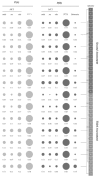Using an Overlapping Time Interval Strategy to Study Diagnostic Instability in Mild Cognitive Impairment Subtypes
- PMID: 31546979
- PMCID: PMC6770378
- DOI: 10.3390/brainsci9090242
Using an Overlapping Time Interval Strategy to Study Diagnostic Instability in Mild Cognitive Impairment Subtypes
Abstract
(1) Background: Mild cognitive impairment (MCI) is a diagnostic label in which stability is typically low. The aim of this study was to examine temporal changes in the diagnosis of MCI subtypes by using an overlapping-time strategy; (2) Methods: The study included 435 participants aged over 50 years with subjective cognitive complaints and who completed at least one follow-up evaluation. The probability of transition was estimated using Bayesian odds ratios; (3) Results: Within the different time intervals, the controls with subjective cognitive complaints represented the largest proportion of participants, followed by sda-MCI at baseline and in the first five intervals of the follow-up, but not in the last eight intervals. The odds ratios indicated higher odds of conversion to dementia in sda-MCI and mda-MCI groups relative to na-MCI (e.g., interval 9-15 months-sda-MCI OR = 9 and mda-MCI OR = 3.36; interval 27-33-sda-MCI OR = 16 and mda-MCI = 5.06; interval 42-48-sda-MCI OR = 8.16 and mda-MCI = 3.45; interval 45-51-sda-MCI OR = 3.31 and mda-MCI = 1); (4) Conclusions: Notable patterns of instability consistent with the current literature were observed. The limitations of a prospective approach in the study of MCI transitions are discussed.
Keywords: Bayesian odds ratios; cognitive aging; conversion to dementia; mild cognitive impairment; screening and diagnosis; subjective cognitive complaints; time overlapping intervals.
Conflict of interest statement
The authors declare no conflict of interest.
Figures




References
-
- Albert M.S., DeKosky S.T., Dickson D., Dubois B., Feldman H.H., Fox N.C., Gamst A., Holtzman D.M., Jagust W.J., Petersen R.C., et al. The diagnosis of mild cognitive impairment due to Alzheimer’s disease: Recommendations from the National Institute on Aging and Alzheimer’s Association workgroup. Alzheimer’s Dement. 2011;7:270–279. doi: 10.1016/j.jalz.2011.03.008. - DOI - PMC - PubMed
Grants and funding
- PSI2014-55316-C3-1-R/Spanish Directorate General of Scientific and Technical Research
- PSI2017-89389-C2-1-R/National Research Agency (Spanish 'Ministry of Science, Innovation and Universities)
- ED431-2017/27/Consellería de Cultura, Educación e Ordenación Universitaria; axudas para a consolidación e estruturación de unidades de investigación competitivas do Sistema Universitario de Galicia

